人教版(2019)必修第一册Unit 4 Natural disasters Listening and speaking 课件 (15张ppt)
文档属性
| 名称 | 人教版(2019)必修第一册Unit 4 Natural disasters Listening and speaking 课件 (15张ppt) | 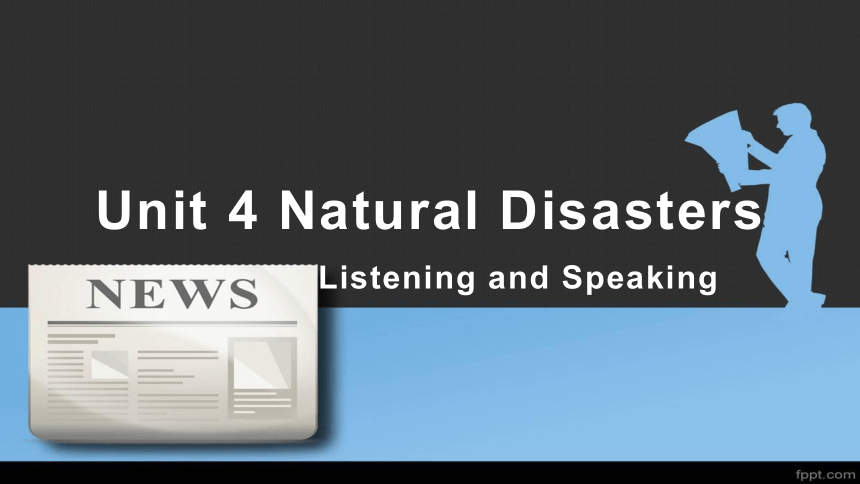 | |
| 格式 | zip | ||
| 文件大小 | 4.2MB | ||
| 资源类型 | 教案 | ||
| 版本资源 | 人教版(2019) | ||
| 科目 | 英语 | ||
| 更新时间 | 2021-12-05 19:09:50 | ||
图片预览

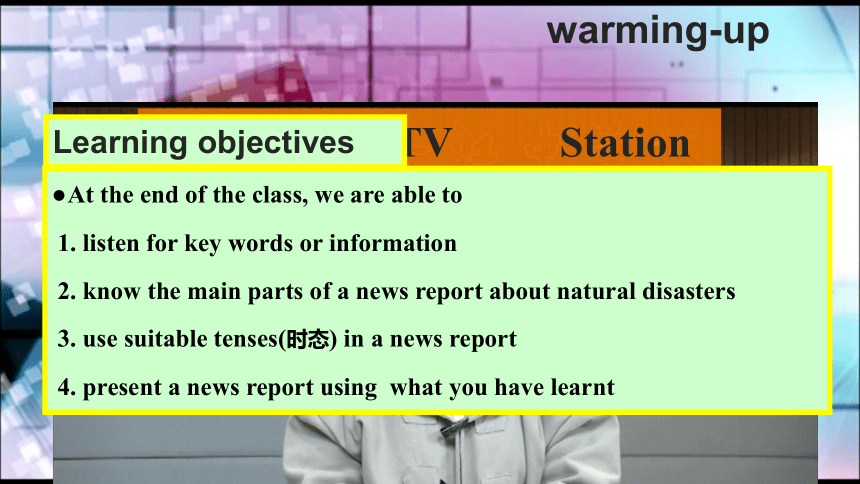
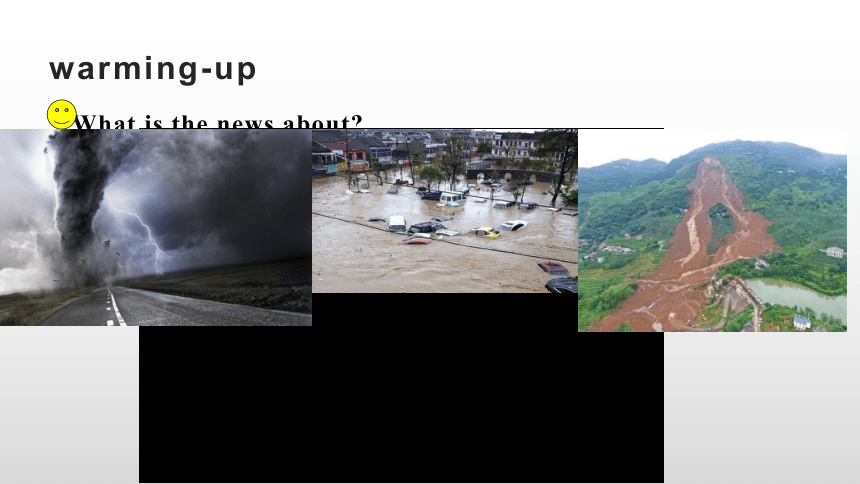
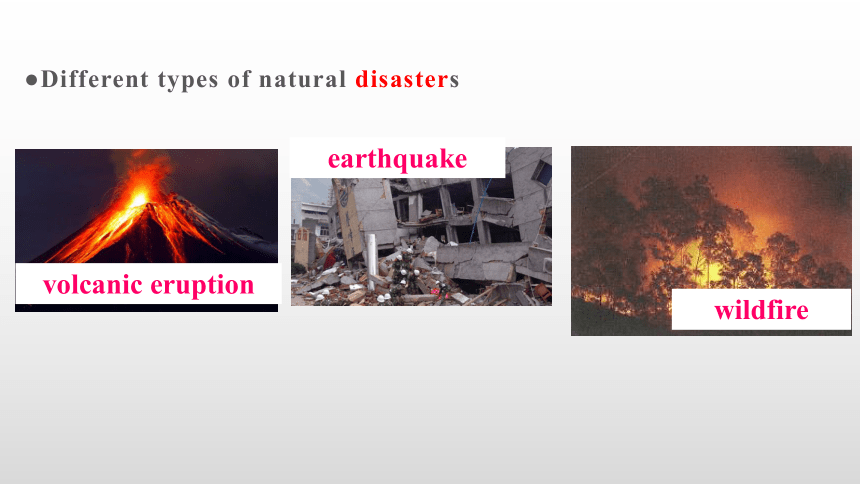
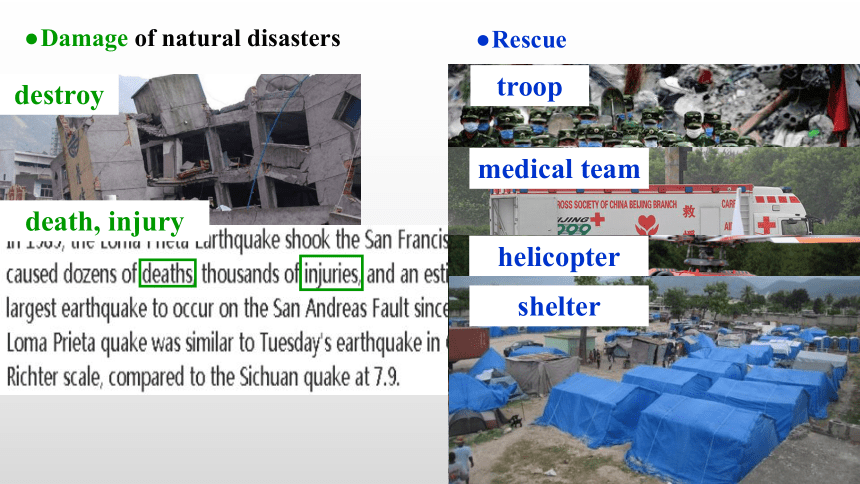
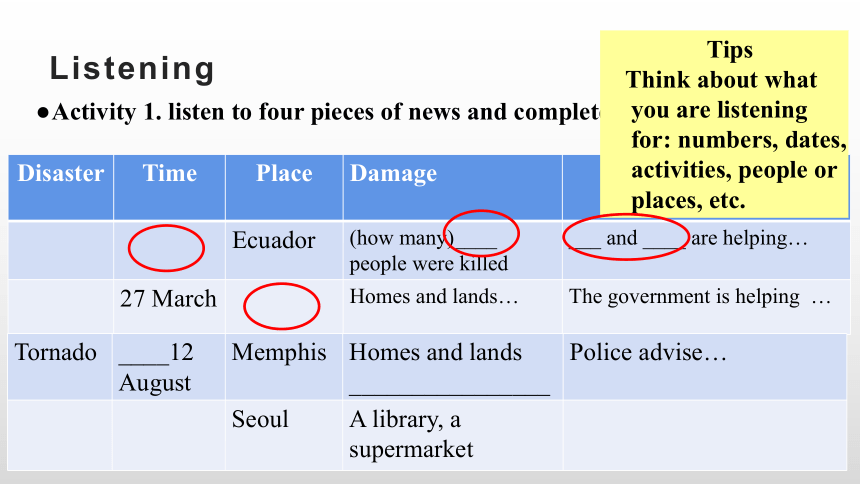

文档简介
(共15张PPT)
Unit 4 Natural Disasters
Listening and Speaking
warming-up
Campus TV Station
Learning objectives
At the end of the class, we are able to
1. listen for key words or information
2. know the main parts of a news report about natural disasters
3. use suitable tenses(时态) in a news report
4. present a news report using what you have learnt
warming-up
What is the news about
A. tsunami B. tornado C. flood D. landslide
Different types of natural disasters
earthquake
volcanic eruption
wildfire
Damage of natural disasters
destroy
Rescue
troop
death, injury
medical team
helicopter
shelter
Listening
Activity 1. listen to four pieces of news and complete the chart.
Disaster Time Place Damage Rescue
Ecuador (how many)____ people were killed ___ and ____ are helping…
27 March Homes and lands… The government is helping …
Tornado ____12 August Memphis Homes and lands ________________ Police advise…
Seoul A library, a supermarket
Tips
Think about what you are listening for: numbers, dates, activities, people or places, etc.
Disaster Time Place Damage Rescue
A strong ________ hit Ecuador Ecuador ________ many buildings ______ people were killed and more than 1,500 _____________ ____________ and _______________ are helping the _________
27 March Homes and lands _____________________. No one_______________ _______. Rescue workers and soldiers ________________________ to make sure that people are safe.
They are also _____________
__________ to those whose homes were lost in the disaster.
damaged
230
were injured
Volunteers
rescue workers
survivors
have been destroyed
have been
killed
are working day and night
bringing food
and water
earthquake
16 April
Flood
Hunan and Jiangxi
Disaster Time Place Damage Rescue
Tornado __________12 August Memphis destroyed ______________. A police officer tells us that at least one person __________. Police advise _________
__________.
Seoul A library, a supermarket and ____________ were damaged. No one __________.
1. What are the main parts of a news report about natural disasters
2. What tense is mainly used in the news
Thinking
at 9:25 a.m.
four homes
avoiding
the area
Land-slide
21 July
several cars
was injured
has died
time
disaster
place
damage
rescue
1. What are the main parts of a news report about natural disasters
2. What kinds of tense are used in the news
did (hit)
disaster
damage
did (damaged, were killed)
have/has done (has died)
rescue
be doing (are helping/working)
Shelters have been set up.
have/has done
Breaking news, 27 March. Extremely frightening floods struck Hunan and Jiangxi, destroying homes and land. As far as I know, no one has been killed by now. Thankfully, the government is helping evacuate over 12,000 people from rising water. Rescue workers and soldiers are working around the clock to ensure safety of the people in affected areas. By now, food and water have been delivered to those whose homes were lost in the disaster.
Tips
Does not use “I”
2. Use plain language
Activity 2. Find out language features.
1. What person should be used
2. The language in the news report should be______.
A. simple and clear B. unreal
C. emotional C. subjective
Speaking
Earthquake
Wenchuan, China
14:28 Monday, 12 May
At least 8,500 killed (by now), thousands of homes destroyed
Rescue workers (medical teams, troops, volunteers, etc.) organized quickly.
Shelters set up.
Survivors have been moved to safety.
Helicopters are being used to deliver the injured.
Tips:
Contain all the five parts of information.
Use suitable tenses.
Does not use “I”.
4. Use plain language.
Good morning. Today is 13 May. ________ hit _______ at ________. ___________________.
___________________.
time
disaster
place
damage
rescue
Activity 3. prepare a short news report.
Presentation
Checklist
Does the conversation contain the following five parts of information
Time place disaster damage rescue
Are the tenses used corrected
did be doing
disaster– did damage rescue
has/have done has/have done
News about
natural disasters
five main parts
time
disaster
place
damage
rescue
tenses
disaster
damage
rescue
(did)
(did)
(have/has done)
(have/has done)
(be doing)
language
plain (simple and clear)
person
the third person
Conclusion
Homework
Write a news report on one of the two disasters on page 49.
Homework
Unit 4 Natural Disasters
Listening and Speaking
warming-up
Campus TV Station
Learning objectives
At the end of the class, we are able to
1. listen for key words or information
2. know the main parts of a news report about natural disasters
3. use suitable tenses(时态) in a news report
4. present a news report using what you have learnt
warming-up
What is the news about
A. tsunami B. tornado C. flood D. landslide
Different types of natural disasters
earthquake
volcanic eruption
wildfire
Damage of natural disasters
destroy
Rescue
troop
death, injury
medical team
helicopter
shelter
Listening
Activity 1. listen to four pieces of news and complete the chart.
Disaster Time Place Damage Rescue
Ecuador (how many)____ people were killed ___ and ____ are helping…
27 March Homes and lands… The government is helping …
Tornado ____12 August Memphis Homes and lands ________________ Police advise…
Seoul A library, a supermarket
Tips
Think about what you are listening for: numbers, dates, activities, people or places, etc.
Disaster Time Place Damage Rescue
A strong ________ hit Ecuador Ecuador ________ many buildings ______ people were killed and more than 1,500 _____________ ____________ and _______________ are helping the _________
27 March Homes and lands _____________________. No one_______________ _______. Rescue workers and soldiers ________________________ to make sure that people are safe.
They are also _____________
__________ to those whose homes were lost in the disaster.
damaged
230
were injured
Volunteers
rescue workers
survivors
have been destroyed
have been
killed
are working day and night
bringing food
and water
earthquake
16 April
Flood
Hunan and Jiangxi
Disaster Time Place Damage Rescue
Tornado __________12 August Memphis destroyed ______________. A police officer tells us that at least one person __________. Police advise _________
__________.
Seoul A library, a supermarket and ____________ were damaged. No one __________.
1. What are the main parts of a news report about natural disasters
2. What tense is mainly used in the news
Thinking
at 9:25 a.m.
four homes
avoiding
the area
Land-slide
21 July
several cars
was injured
has died
time
disaster
place
damage
rescue
1. What are the main parts of a news report about natural disasters
2. What kinds of tense are used in the news
did (hit)
disaster
damage
did (damaged, were killed)
have/has done (has died)
rescue
be doing (are helping/working)
Shelters have been set up.
have/has done
Breaking news, 27 March. Extremely frightening floods struck Hunan and Jiangxi, destroying homes and land. As far as I know, no one has been killed by now. Thankfully, the government is helping evacuate over 12,000 people from rising water. Rescue workers and soldiers are working around the clock to ensure safety of the people in affected areas. By now, food and water have been delivered to those whose homes were lost in the disaster.
Tips
Does not use “I”
2. Use plain language
Activity 2. Find out language features.
1. What person should be used
2. The language in the news report should be______.
A. simple and clear B. unreal
C. emotional C. subjective
Speaking
Earthquake
Wenchuan, China
14:28 Monday, 12 May
At least 8,500 killed (by now), thousands of homes destroyed
Rescue workers (medical teams, troops, volunteers, etc.) organized quickly.
Shelters set up.
Survivors have been moved to safety.
Helicopters are being used to deliver the injured.
Tips:
Contain all the five parts of information.
Use suitable tenses.
Does not use “I”.
4. Use plain language.
Good morning. Today is 13 May. ________ hit _______ at ________. ___________________.
___________________.
time
disaster
place
damage
rescue
Activity 3. prepare a short news report.
Presentation
Checklist
Does the conversation contain the following five parts of information
Time place disaster damage rescue
Are the tenses used corrected
did be doing
disaster– did damage rescue
has/have done has/have done
News about
natural disasters
five main parts
time
disaster
place
damage
rescue
tenses
disaster
damage
rescue
(did)
(did)
(have/has done)
(have/has done)
(be doing)
language
plain (simple and clear)
person
the third person
Conclusion
Homework
Write a news report on one of the two disasters on page 49.
Homework
